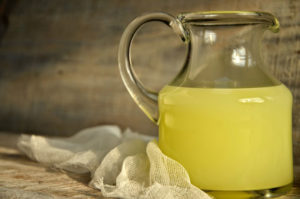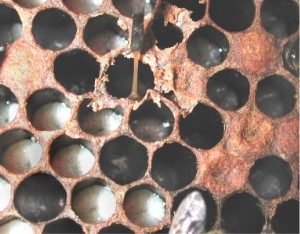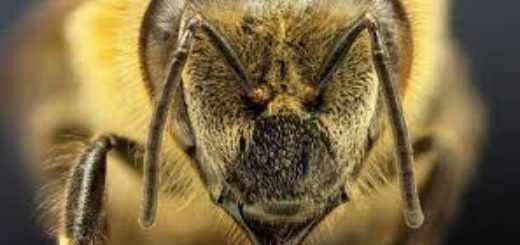whey: treatment foul brood of bees
 Treatment of foul brood bees buttermilk.
Treatment of foul brood bees buttermilk.
In beekeeping common a problem, as foulbrood.
This dangerous disease threatens the entire apiary and requires urgent measures by the beekeeper.
The danger is that foul brood, it affects brood.
There 3 types of diseases: American, European, parahnylets.
The common feature of all types – defeat brood, as it begins to deteriorate cover, there are holes.
The process of treating all kinds of diseases is very complex, long, requiring the use of powerful and effective antibiotics.
infection process
Bees infected through infected larvae ailments, namely, their corpses.
exept this, You can pick up the disease from young bees, purifying cells.
They begin to feed larvae with honey dangerous pathogen illness.
Moving to another apiary foul brood can be done through the WTO, honey production, hives, pollen, pollen, frames with brood and wax, Beekeeper and equipment.
Upon detection of the parasite is important to immediately begin correct treatment of bees, otherwise you can incur huge losses.
It is important! Most, bring infection ants, axis, and ticks waxes miles.
Affliction affects different regions, it is able to adapt to different weather conditions.
Features illness
American type infects larvae, situated alone in different places.
Result – disease affecting brood. After his exposure cells are devastated, there is a huge number of dead larvae, in brood formed variegation.
Mainly, ill adult larvae, located in sealed brood.
The bodies appear below cells, they are a viscous substance, resembling a conventional adhesive.
There pungent smell of glue.
It is important to remember, American kind of disease that is able to affect the wax lids, which become dark.
exept this, There are a lot of holes, disengaging from, that the larvae dry, significantly reduced their size, therefore can pull down cell.
After drying consistency observed following:
- rot stick to cells, located at the bottom;
- appear brown, and dark brown, from which it is very difficult to get rid;
- beekeeper fails to clean the mold, as influenced needles, They destroyed tweezers;
- individual parent refuses to stay in such conditions.
Regarding European foul brood bees, after the death of the larvae formed black viscous substance, similar to the, affecting American version.
Though, that they are difficult to distinguish from each other, symptoms of different diseases:
- first no smell of dead larvae;
- after a while there is a sour smell;
- cadaverous smell may occur;
- larvae firmly fixed in cells, so the insects can not get rid of them, begin to gnaw;
- brood has a colorful appearance.
Parahnylets has other symptoms:
- printed brood;
- bulging lids cells;
- Color is dark flip-off caps, and in the center there is a deepening, the shape of a cone;
- dead brood like dough;
- there putrid smell;
- dead pupae from leaking yellow, gray;
- difficult to get rid of larvae.
It is important to promptly respond to the symptoms and start the right treatment. This will avoid unnecessary losses.
Features of medical treatment
Proactively regularly inspecting bees (at least once every fourteen days), to detect the disease and begin treatment.
The only way to avoid tragic consequences and losses for the entire apiary.
 Finding disease among bees, must notify the veterinarian, which is to take cells for bacteriological analysis.
Finding disease among bees, must notify the veterinarian, which is to take cells for bacteriological analysis.
In no case should not be wrapped in paper honeycombs, they are placed in the appropriate wooden box, not to damage.
WordHex examined from different families of bees.
After five days, you can get the results of bacteriological analysis.
It is important to remember, and that the European American foulbrood difficult to treat of drugs.
In this case it is necessary to analyze, which will help determine the sensitivity of the pathogen of bees.
If the tests confirm the presence of foul brood, must close apiary in quarantine for 1 year, that the infection does not spread throughout the area.
It is strictly forbidden to establish new hives in the apiary, buy bee family, engage in selling wax, transport of infected bees, and lend inventory other beekeepers.
If the disease struck about five percent of larvae, isolate them, and the remaining check.
If the infection has spread more, than five percent, do not make such events.
Treatment foul brood of bees includes a special rehabilitation apiary:
- Implemented mandatory transplant into new hives of bees.
- Framework, containing dead larvae, to be destroyed.
- Reduction, slot insulation.
- Instead of the old framework set new, equipped with Wax.
- Sick bees shaken near notch, then send smoke again.
- Paper burns, clean combs and hive, disinfecting them.
- If the frame many healthy individuals, they are placed in an incubator family.
Folk treatment
Effective and harmless way to treat this disease among bees is whey.
It looks like yellowish clear liquid. So from cow's milk.
It can be used in the treatment of, prevention of bees, To increase the chances of recovery.
It is important to remember, that this tool is prohibited to use, if the European type of crust in the cells are dead larvae.
These cells need peretopyty in wax.
Preparation means for bees:
- It will take cow's milk, which is necessary for skvasit 50-60 hours, leaving him at 25 C. It is necessary to wait for the allocation of appropriate fluids.
- Then you get rid of the fat layer, and the enemy liquid heated to eighty degrees. Cool, strain through cheesecloth for.
- The resulting liquid can be drained in an enamel bowl, covering mouth with gauze. Within five days stand at ambient temperature 25 C. If the temperature exceeds 35 C – three age. Then it should be filtered using gauze.
The treatment received by means of bees:
- for the treatment of bees buttermilk important to choose the right time, namely – morning or evening time, When insects are located in hive;
- to get a fine spray, You can use a special bulb, capacity is approximately 500 milliliters;
- frames are processed once, Bees do not need to shake. After two weeks of this treatment can be carried Reprocessing, if the remaining clinical symptoms;
- before the treatment is necessary to remove the lid from the hive, wadding, insulating cushion. Irrigation takes place at a height of thirty centimeters in relation to the framework surface. For one frame will need about 20 grams of whey. Regarding Multiple hives, then treatment should start from the lower hulls;
- treating cellular framework, they need to be put in its place.
The disease capable of causing significant damage to the apiary. Need urgent intervention Beekeeper.
In order to avoid complications, need time to start competent treatment.




I'm from Peru. I want to know how to cure and prevent dry breeding. Because I'm just learning about this job..